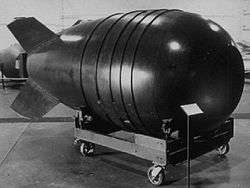Mark 6 nuclear bomb

The Mark 6 nuclear bomb was an American nuclear bomb based on the earlier Mark 4 nuclear bomb and its predecessor, the Mark 3 Fat Man nuclear bomb design.
The Mark 6 was in production from 1951 to 1955 and saw service until 1962. Seven variants and versions were produced, with a total production run of all models of 1100 bombs.
The basic Mark 6 design was 61 inches (150 cm) in diameter and 128 inches (330 cm) long, the same basic dimensions as the Mark 4 and close to the Mark 3. Various models of the Mark 6 were roughly 25% lighter than either the Mark 4 or Fat Man, and weighed 7,600 to 8,500 pounds (3,400–3,900 kg).
Early models of the Mark 6 utilized the same 32-point implosion system design concept as the earlier Mark 4 and Mark 3; the Mark 6 Mod 2 and later used a different, 60-point implosion system.
Various models and pit options gave nuclear yields of 8, 26, 80, 154, and 160 kilotons for Mark 6 models.
Survivors
A Mark 6 casing is on display in the Cold War Gallery of the National Museum of the United States Air Force in Dayton, Ohio.
Another is on display at the Museum of Aviation (Warner Robins).
Variants
Mark 13
The Mark 13 nuclear bomb and W13 missile warhead were developed as higher-efficiency Mark 6 successors, the same size and basic configuration as the Mark 6 but utilizing an improved 92-point implosion system. The Mark 13 was cancelled in August 1954 and the W13 cancelled September 1954, in both cases without ever seeing production service.
Mark 18
The Mark 18 nuclear bomb was a follow-on to the Mark 6 and Mark 13, utilizing a fissile pit assembly with around 60 kilograms of HEU and delivering a yield of 500 kilotons, the largest pure-fission (non-thermonuclear) bomb design ever developed by the US. Mark 18 bombs were eventually recycled into Mark 6 Mod 6 bombs after thermonuclear weapons were deployed in quantity. The Mark 18 was tested once in Operation Ivy King.
See also
External links
| Wikimedia Commons has media related to Mark 6 nuclear bomb. |
- Allbombs.html list of all US nuclear warheads at nuclearweaponarchive.org